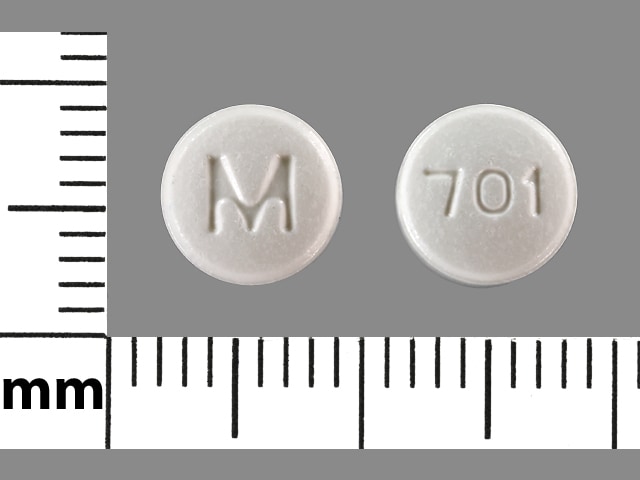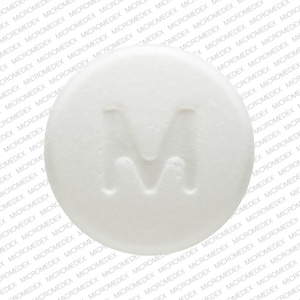Dosage Forms
Excipient information presented when available (limited, particularly for generics); consult specific product labeling. [DSC] = Discontinued product
Tablet, Oral:
Maxalt: 5 mg [DSC], 10 mg
Generic: 5 mg, 10 mg
Tablet Disintegrating, Oral:
Maxalt-MLT: 5 mg [DSC], 10 mg [contains aspartame; peppermint flavor]
Generic: 5 mg, 10 mg
Pharmacology
Mechanism of Action
Selective agonist for serotonin (5-HT1B and 5-HT1D receptors) in cranial arteries; causes vasoconstriction and reduces sterile inflammation associated with antidromic neuronal transmission correlating with relief of migraine
Pharmacokinetics/Pharmacodynamics
Absorption
Complete
Distribution
Vd: Females: 110 L; Males 140 L
Metabolism
Via monoamine oxidase-A; forms metabolites; significant first-pass metabolism
Excretion
Urine (82%, 14% as unchanged drug); feces (12%)
Onset of Action
Most patients have response to treatment within 2 hours
Time to Peak
Maxalt: 1 to 1.5 hours; Maxalt-MLT: 1.6 to 2.5 hours
Half-Life Elimination
2-3 hours
Protein Binding
14%
Use in Specific Populations
Special Populations: Renal Function Impairment
In patients with CrCl 10 to 60 mL/min/1.73 m2, the AUC0-∞ of rizatriptan was not significantly different. In hemodialysis patients (CrCl less than 2 mL/min/1.73 m2), the AUC for rizatriptan was approximately 44% greater than that in patients with healthy renal function.
Special Populations: Hepatic Function Impairment
Plasma concentrations of rizatriptan were approximately 30%greater in patients with moderate hepatic insufficiency.
Special Populations: Elderly
Rizatriptan pharmacokinetics in healthy elderly nonmigraineur volunteers (65 to 77 y of age) were similar to those in younger nonmigraineur volunteers (18 to 45 y of age).
Special Populations: Gender
AUC is approximately 30% higher and Cmax is 11% higher in women than in men.
Special Populations: Race
Pharmacokinetic data revealed no significant differences between black and white subjects.
Use: Labeled Indications
Migraine: Acute treatment of migraine with or without aura
Contraindications
Hypersensitivity to rizatriptan or any component of the formulation; documented ischemic heart disease or other significant cardiovascular disease; coronary artery vasospasm (including Prinzmetal angina); history of stroke or transient ischemic attack; peripheral vascular disease; ischemic bowel disease; uncontrolled hypertension; basilar or hemiplegic migraine; during or within 2 weeks of MAO inhibitors; during or within 24 hours of treatment with another 5-HT1 agonist, or an ergot-containing or ergot-type medication (eg, methysergide, dihydroergotamine)
Canadian labeling: Additional contraindications (not in US labeling): Ophthalmoplegic migraine; severe hepatic impairment.
Dosage and Administration
Dosing: Adult
Note: In patients with risk factors for coronary artery disease, following adequate evaluation to establish the absence of coronary artery disease, the initial dose should be administered in a setting where response may be evaluated (physician's office or similarly staffed setting). ECG monitoring may be considered.
Migraine: Oral: 5 to 10 mg, repeat after 2 hours if significant relief is not attained; maximum: 30 mg/24 hours
Dose adjustment with concomitant propranolol therapy: 5 mg/dose (maximum: 15 mg/24 hours)
Dosing: Geriatric
Refer to adult dosing.
Dosing: Pediatric
Migraine, acute treatment:
Children ≥6 years and Adolescents: Oral: Note: Safety and efficacy of multiple rizatriptan doses in a 24-hour period has not been established for pediatric patients.
<40 kg: 5 mg as a single dose
≥40 kg: 10 mg as a single dose
Dosage adjustment with concomitant propranolol:
Children and Adolescents 6 to 17 years:
<40 kg: Do not use rizatriptan
≥40 kg: 5 mg as a single dose; maximum: 5 mg in a 24-hour period
Adolescents ≥18 years: 5 mg; may repeat after 2 hours; maximum daily dose: 15 mg in a 24-hour period
Administration
May be administered with or without food. For orally-disintegrating tablets (Maxalt-MLT), patient should be instructed to place tablet on tongue and allow to dissolve. Dissolved tablet will be swallowed with saliva.
Dietary Considerations
Some products may contain phenylalanine.
Storage
Store at room temperature of 15°C to 30°C (59°F to 86°F); orally disintegrating tablets should be stored in blister pack until administration.
Rizatriptan Images
Drug Interactions
Droxidopa: Serotonin 5-HT1D Receptor Agonists (Triptans) may enhance the hypertensive effect of Droxidopa. Monitor therapy
Ergot Derivatives: May enhance the vasoconstricting effect of Serotonin 5-HT1D Receptor Agonists (Triptans). Serotonin 5-HT1D Receptor Agonists (Triptans) may enhance the vasoconstricting effect of Ergot Derivatives. Exceptions: Nicergoline. Avoid combination
Monoamine Oxidase Inhibitors: Serotonin 5-HT1D Receptor Agonists (Triptans) may enhance the serotonergic effect of Monoamine Oxidase Inhibitors. This could result in serotonin syndrome. Monoamine Oxidase Inhibitors may increase the serum concentration of Serotonin 5-HT1D Receptor Agonists (Triptans). Exceptions: Rasagiline; Safinamide; Selegiline. Avoid combination
Propranolol: May increase the serum concentration of Rizatriptan. Management: Rizatriptan adult dose should be reduced to 5 mg in patients who are also being treated with propranolol. Consider therapy modification
Serotonergic Agents (High Risk): Serotonin 5-HT1D Receptor Agonists (Triptans) may enhance the serotonergic effect of Serotonergic Agents (High Risk). This could result in serotonin syndrome. Management: Monitor for signs and symptoms of serotonin syndrome/serotonin toxicity (eg, hyperreflexia, clonus, hyperthermia, diaphoresis, tremor, autonomic instability, mental status changes) when these agents are combined. Exceptions: Isocarboxazid; Linezolid; Methylene Blue; Moclobemide; Phenelzine; Tranylcypromine. Monitor therapy
SUMAtriptan: Serotonin 5-HT1D Receptor Agonists (Triptans) may enhance the adverse/toxic effect of SUMAtriptan. Avoid combination
Adverse Reactions
1% to 10%:
Cardiovascular: Chest pain (≤3%), flushing (>1%), palpitations (>1%), flushing
Central nervous system: Dizziness (4% to 9%), drowsiness (4% to 8%), fatigue (adults: 4% to 7%; children: >1%), paresthesia (3% to 4%), pain (3%), feeling of heaviness (≤2%), headache (≤2%), euphoria (>1%), hypoesthesia (>1%)
Gastrointestinal: Nausea (4% to 6%), xerostomia (3%), sore throat (≤2%), abdominal distress (children: >1%), diarrhea (>1%), vomiting (>1%)
Neuromuscular & skeletal: Weakness (4% to 7%), jaw pain (≤2%), jaw pressure (≤2%), jaw tightness (≤2%), neck pain (≤2%), neck pressure (≤2%), neck tightness (≤2%), tremor (>1%)
Respiratory: Pharyngeal edema (≤2%), pressure on pharynx (≤2%), dyspnea (>1%)
<1%, postmarketing, and/or case reports: Abdominal distention, abnormal gait, agitation, anaphylaxis, anaphylactoid reaction, angina pectoris, angioedema, ataxia (children), auditory impairment (children), blurred vision, bradycardia, cardiac arrhythmia, cold extremities, confusion, diaphoresis, dysgeusia, dyspepsia, edema, erythema, facial edema, hallucination (children), hot flash, hypertensive crisis, increased blood pressure (diastolic/systolic), insomnia, ischemic heart disease, lack of concentration (children), memory impairment, muscle rigidity, muscle spasm, myalgia, myocardial infarction, pharyngeal edema, pruritus, seizure, skin rash, swelling of eye, syncope, tachycardia, tinnitus, tongue edema, toxic epidermal necrolysis, urticaria, vasospasm, vertigo, wheezing
Warnings/Precautions
Concerns related to adverse effects:
- Cardiac events: Coronary artery vasospasm, transient ischemia, myocardial infarction, ventricular tachycardia/fibrillation, cardiac arrest, and death have been reported with 5-HT1 agonist administration. Patients who experience sensations of chest pain/pressure/tightness or symptoms suggestive of angina following dosing should be evaluated for coronary artery disease or Prinzmetal's angina before receiving additional doses; if dosing is resumed and similar symptoms recur, monitor with ECG.
- Cerebrovascular events: Cerebral/subarachnoid hemorrhage and stroke have been reported with 5-HT1 agonist administration. Use is contraindicated in patients with a history of stroke or transient ischemic attack
- Elevated blood pressure: Significant elevation in blood pressure, including hypertensive crisis, has also been reported on rare occasions in patients with and without a history of hypertension.
- Headaches: Acute migraine agents (eg, triptans, opioids, ergotamine, or a combination of the agents) used for 10 or more days per month may lead to worsening of headaches (medication overuse headache); withdrawal treatment may be necessary in the setting of overuse.
- Vasospasm-related events: Peripheral vascular ischemia and colonic ischemia, gastrointestinal ischemia/infarction, splenic infarction, and Raynaud syndrome have been reported with 5-HT1 agonist.
- Visual effects: Rarely, partial vision loss and blindness (transient and permanent) have been reported with 5-HT1 agonist.
Disease-related concerns:
- Coronary artery disease: Should not be given to patients who have risk factors for CAD (eg, hypertension, hypercholesterolemia, smoker, obesity, diabetes, strong family history of CAD, menopause, male >40 years of age) without adequate cardiac evaluation. Patients with suspected CAD should have cardiovascular evaluation to rule out CAD before considering use; if cardiovascular evaluation is “satisfactory,” first dose should be given in the healthcare provider's office (consider ECG monitoring). Periodic evaluation of cardiovascular status should be done in all patients.
- Hepatic impairment: Use with caution in patients with hepatic impairment; drug clearance may be reduced leading to increased plasma concentrations.
- Renal impairment: Use with caution in dialysis patients (systemic exposure is increased).
Concurrent drug therapy issues:
- Serotonin syndrome: Symptoms of agitation, confusion, hallucinations, hyper-reflexia, myoclonus, shivering, and tachycardia may occur with concomitant proserotonergic drugs (ie, SSRIs/SNRIs or triptans) or agents which reduce rizatriptan's metabolism. Concurrent use of serotonin precursors (eg, tryptophan) is not recommended. If concomitant administration with SSRIs is warranted, monitor closely, especially at initiation and with dose increases.
Dosage form specific issues:
- Phenylalanine: Maxalt-MLT tablets contain phenylalanine.
Other warnings/precautions:
- Appropriate use: Only indicated for treatment of acute migraine; not for the prevention of migraines or the treatment of cluster headache. If a patient does not respond to the first dose, the diagnosis of migraine should be reconsidered.
Monitoring Parameters
Headache severity, signs/symptoms suggestive of angina; consider monitoring blood pressure, heart rate, and/or ECG with first dose in patients with likelihood of unrecognized coronary disease, such as patients with significant hypertension, hypercholesterolemia, obese patients, patients with diabetes, smokers with other risk factors or strong family history of coronary artery disease
Pregnancy
Pregnancy Considerations
A registry has been established to monitor outcomes of women exposed to rizatriptan during pregnancy. Preliminary data from the pregnancy registry (prospectively collected from 65 live births 1998-2004) does not show an increased risk of congenital malformations in comparison to the general population (Fiore 2005). Additional information collected through 2018 has not shown a pattern of birth defects or other adverse outcomes; however, data is limited and loss to follow-up is significant. Information related to rizatriptan use in pregnancy is limited in comparison to other medications in this class (Källén 2011; Nezvalová-Henriksen 2010; Nezvalová-Henriksen 2012; Nezvalová-Henriksen 2013; Spielmann 2018).
Until additional information is available, other agents are preferred for the initial treatment of migraine in pregnancy (MacGregor 2014; Worthington 2013).
Patient Education
What is this drug used for?
- It is used to treat migraine headaches.
Frequently reported side effects of this drug
- Fatigue
- Loss of strength and energy
Other side effects of this drug: Talk with your doctor right away if you have any of these signs of:
- Severe cardiac abnormalities like chest, throat, neck, or jaw tightness, pain, pressure, or heaviness; break out in a cold sweat; shortness of breath; fast heartbeat; abnormal heartbeat; or severe dizziness or passing out
- Severe cerebrovascular disease like change in strength on one side is greater than the other, trouble speaking or thinking, change in balance, or vision changes
- Severe or persistent headache
- Severe dizziness
- Passing out
- Vision changes
- Blindness
- Burning or numbness feeling
- Constipation
- Diarrhea
- Severe nausea
- Vomiting
- Severe abdominal pain
- Bloody diarrhea
- Weight loss
- Leg cramps
- Sensation of heaviness or tightness in legs
- Sensation of cold
- Burning or aching in feet or toes
- Mood changes
- Skin discoloration
- Serotonin syndrome like dizziness, severe headache, agitation, sensing things that seem real but are not, fast heartbeat, abnormal heartbeat, flushing, tremors, sweating a lot, change in balance, severe nausea, or severe diarrhea
- Signs of a significant reaction like wheezing; chest tightness; fever; itching; bad cough; blue skin color; seizures; or swelling of face, lips, tongue, or throat.
Note: This is not a comprehensive list of all side effects. Talk to your doctor if you have questions.
Consumer Information Use and Disclaimer: This information should not be used to decide whether or not to take this medicine or any other medicine. Only the healthcare provider has the knowledge and training to decide which medicines are right for a specific patient. This information does not endorse any medicine as safe, effective, or approved for treating any patient or health condition. This is only a brief summary of general information about this medicine. It does NOT include all information about the possible uses, directions, warnings, precautions, interactions, adverse effects, or risks that may apply to this medicine. This information is not specific medical advice and does not replace information you receive from the healthcare provider. You must talk with the healthcare provider for complete information about the risks and benefits of using this medicine.









